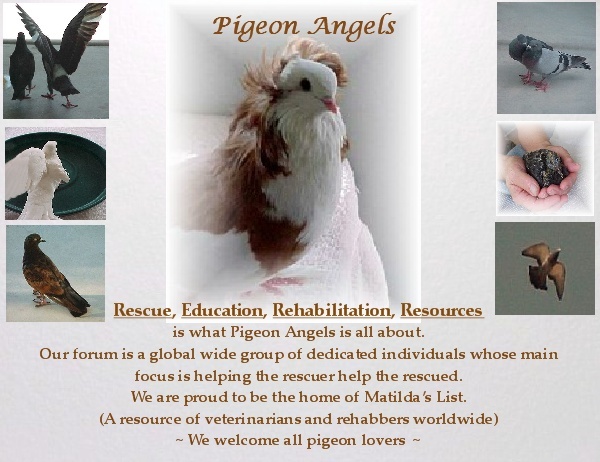This isn't one of my own rescues, but I want to share it anyway!
About three weeks ago Les telephoned me to say that one of his garden pigeons was ill and that the vet found out he had a lead pellet in his gizzard. This showed up on the X-ray and the pigeon was showing symptoms of lead poisoning.
The vet told Les that the pigeon would die slowly, and offered to euthanase. Les didn't want that so he was advised to get some sodium calciumedetate, which is the antidote to lead poisoning, and inject that daily. The pigeon, however, would eventually die. He couldn't perform surgery because it would be too traumatic for the pigeon...he mentioned the possibility of using an endoscope to remove the pellet, but his surgery wasn't equiped with one.
Les rang me about this because the vet had told him the pigeon would be better off in an aviary for his last days, so the plan was for the pigeon - Jumbo -to come up here. Les' big problem was that no one seemed to have any sodium calciumedetate.
I looked up lead poisoning in Les Stocker's book "Practical Wildlife Care" and sent the information to Les. This is what it said (please bear in mind that the dosage is for a swan!)
If not treated promptly lead poisoning will kill...Lead poisoning causes anorexia which leads to emaciation, anaemia, muscle weakness, bright green droppings and a general malaise. The gizzard, a muscle ceases to function and even if the bird can eat, its foodstuffs are not processed and congeal in the proventriculus and the oesophagus.
Clinical symptoms of lead poisoning include emaciation, lethargy, bright green droppings and limber neck where the lower part of the neck lies across the bird's back, although other factors may be involved. Blood analysis may be used but some swans have a naturally high lead reading and are not ill. Radiographs of the gizzard and the clinical symptoms are a better guide. Lead shot will appear as radio opaque.
Once x-rayed the swan should be put on an intravenous drip using a 22g catheter in the medial tarsal vein secured with a lot of adhesive tape. This mans that if the bird wishes to stand or change position it can and it also eliminates the need for constant supervision or sedation. 5ml of sodium Calciumedetate Strong) (*Animalcare) should be added to a 1 litre bag of Hartmann's solution with 10ml of Duphalyte (Fort Dodge Animal Health). A 2ml subcutaneous injection of vitamin B12 should be given. The thigh is the best injection site as it does not bruise as much as the breast. The intravenous drip should be maintained for 48 hours with a second bag of fluids and medication running consecutively. A 48 hour break should be taken and then a daily subcutaneous injection of Sodium Calciumeddetate (Strong) (Animalcare) and water be given until the appetite has returned. Post lead-poisoned swans vw ery often will suffer with absorption and digestive problems and may need to remain in care for a considerable time or possibly be rehomed in a safe environment where a good diet can be maintained...
It used to be a common practice to remove the lead from the gizzard surgically. This is now considered too traumatic and surgery on an already debilitated swan is rarely a good idea...it is better to encorage both an extra intake of grit and drinking to speedily evacuate any metals. This offered some hope. Les got on the telephone and managed to find a supplier who got a sample of calcium sodiumedetate from the manufacturer. He also spoke to Professor of Toxicology at Guys Hospital London who said that lead is a very nasty poison but also felt that it didn't always kill...
I heard nothing further about Jumbo until yesterday, when I e-mailed Les to suggest that the vet I had visited that day might be able to remove the pellet as he had the right equipment. Imagine my delight when Les said that the latest X-rays showed that the pellet was no longer there...it had apparently been evacuated! Jumbo will be returning to the flock that feeds in Les' garden.
Isn't it nice when things work out?

Cynthia
__________________


